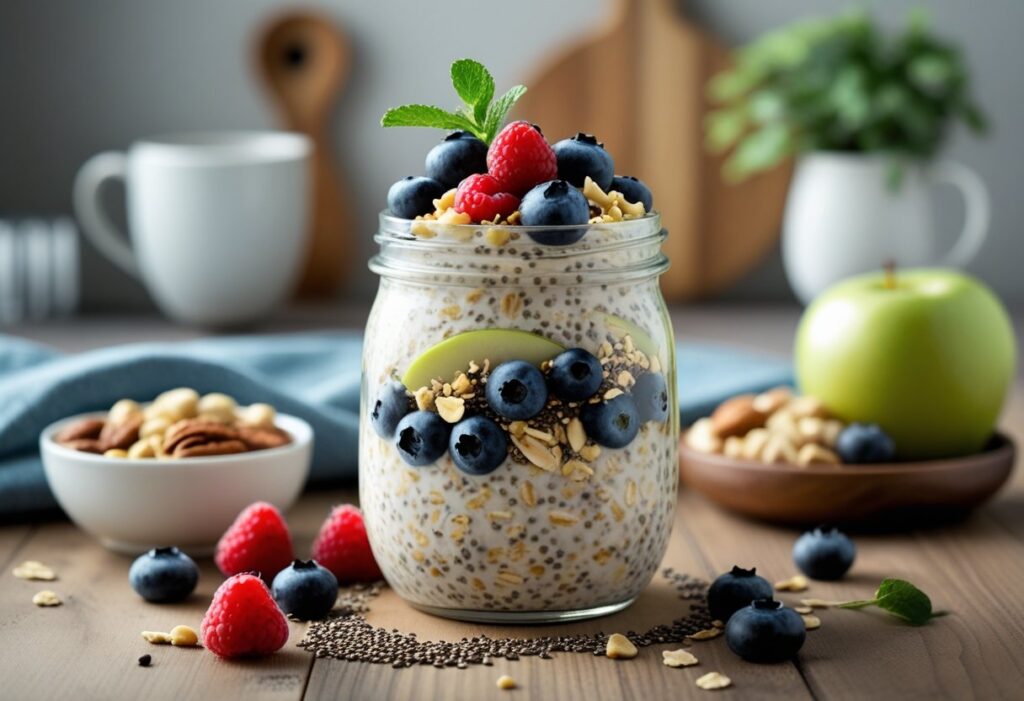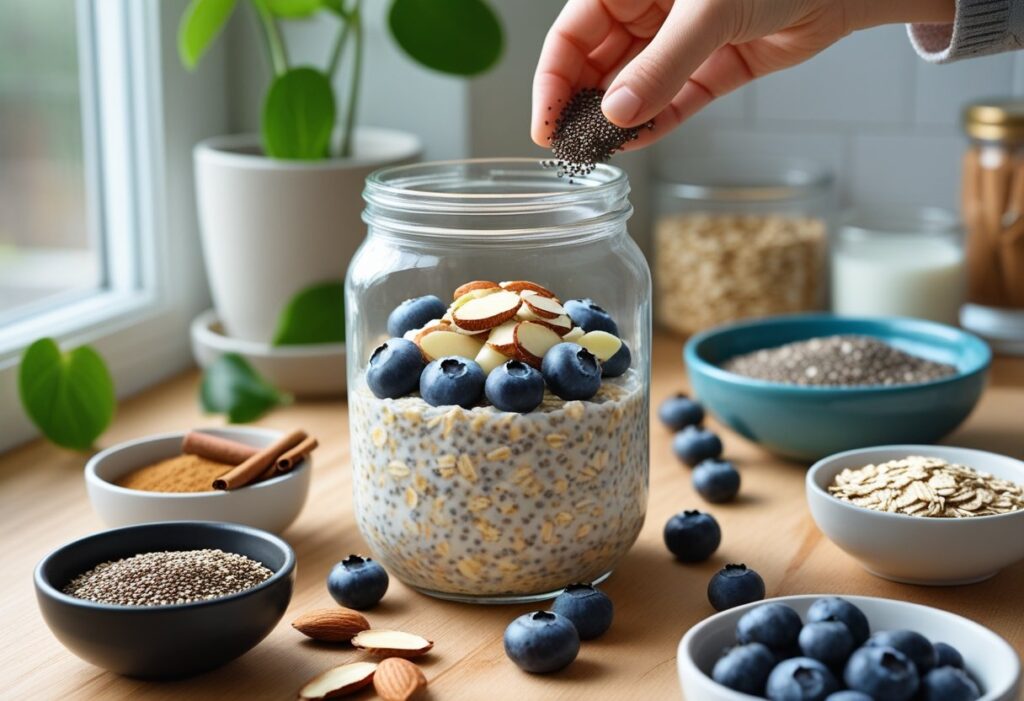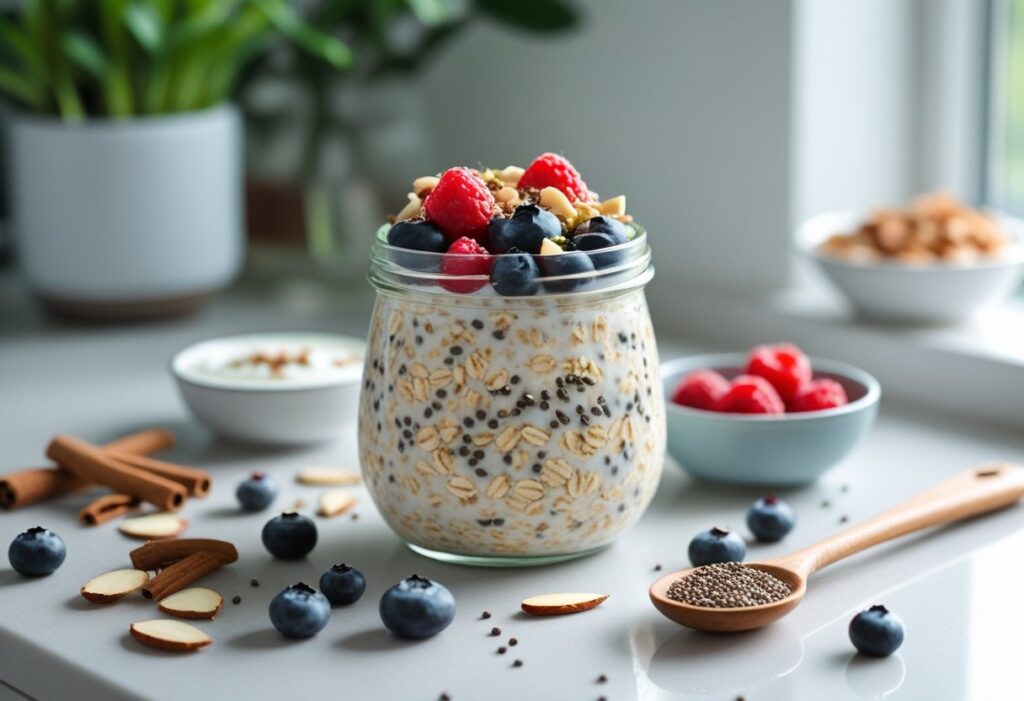Breakfast can be tough for people with diabetes, especially when you’re juggling convenience and blood sugar control. So many classic breakfast foods just spike your glucose, and honestly, who has time to cook every morning?
Overnight oats can be a diabetes-friendly breakfast option when you pick the right ingredients to keep your blood sugar steady. The trick is to focus on fiber, protein, and healthy fats, and not go overboard on the carbs.
This combo slows down digestion and helps prevent the sharp blood sugar jumps you get from regular oatmeal. Plus, overnight oats are ridiculously easy to prep ahead.
You get to control every ingredient, which is a game changer for anyone watching their blood sugar. With some planning around ingredients, sweeteners, and portions, overnight oats offer a balanced and convenient morning option that actually fits diabetes management goals.
Key Takeaways
- Overnight oats help manage blood sugar when you use fiber, protein, and healthy fats
- Smart ingredient picks and portion control make overnight oats diabetes-friendly
- Prepping a few jars ahead means you’ve got quick, glucose-friendly breakfasts on hand
Benefits of Overnight Oats for Diabetes

Overnight oats have some real perks for folks managing diabetes, especially when it comes to blood sugar control and steady energy. When you mix fiber, protein, and healthy fats, you end up with a meal that keeps glucose more stable all morning.
Managing Glucose Levels
Overnight oats slow down sugar absorption and help you avoid those nasty blood sugar and insulin spikes. Soaking the oats keeps their glycemic impact low, especially if you use skim milk.
Oats have a special soluble fiber called beta-glucan. When you eat it, it turns into a gel in your gut and slows down how quickly glucose gets into your system.
Key glucose benefits include:
- Less post-meal blood sugar spiking
- Lower insulin response compared to most cereals
- Energy that lasts for hours
- More stable blood sugar through the morning
Protein in overnight oats is a big deal for blood sugar, too. Adding Greek yogurt, protein powder, or nuts ups the protein, which slows how fast your stomach empties and how quickly glucose gets absorbed.
Fiber and Satiety
Oats are loaded with beta-glucan, a soluble fiber that’s linked to all sorts of good stuff—lower cholesterol, healthier blood pressure, and even a reduced risk of type 2 diabetes.
That fiber fills you up, sometimes for hours. If you’re the type who gets snacky mid-morning, this could be your secret weapon.
Fiber benefits for diabetics:
- Better gut health and digestion
- Improved cholesterol numbers
- Fuller for longer, so fewer cravings
- Slower nutrient absorption
Soaking overnight breaks down the oats a bit, making the fiber easier to use but still great for blood sugar. If portion control is a struggle, fiber’s satiety helps you out.
Role of Healthy Fats
Healthy fats in overnight oats slow digestion even more and help keep blood sugar stable. Toss in some nuts, seeds, or nut butter for those good fats and a protein boost.
These fats help your body absorb fat-soluble vitamins from the rest of your breakfast. Plus, they help keep your blood sugar steady for longer stretches.
Common healthy fat additions:
- Almonds or almond butter
- Chia seeds or flaxseeds
- Walnuts
- Natural peanut butter
Mixing fiber, protein, and healthy fats gives you a nice macronutrient balance. That’s crucial for anyone who needs to manage their blood sugar after meals.
And let’s be honest—healthy fats make overnight oats taste better and feel more satisfying. That might be what keeps you coming back to this breakfast.
Choosing the Right Ingredients for Diabetic-Friendly Overnight Oats

If you pick the right stuff, overnight oats can actually be super blood sugar-friendly. Steel-cut or rolled oats are better than instant, and protein-rich add-ins like Greek yogurt help keep your blood sugar on track.
Selecting the Best Oats
Steel-cut oats are your best bet for diabetes. They have the lowest glycemic index and take longer to digest, so you’re less likely to get a blood sugar spike.
Old-fashioned rolled oats are a solid second choice. They cook faster but still have plenty of fiber. Stick to about 1/2 cup to keep carbs in check.
Skip instant oats. They’re way too processed, break down fast, and can send your blood sugar soaring—just not worth it.
| Oat Type | Glycemic Impact | Best for Diabetes |
|---|---|---|
| Steel-cut | Lowest | Yes |
| Rolled | Moderate | Yes |
| Instant | Highest | No |
Protein Sources
Greek yogurt is probably the best protein for overnight oats. It’s got double the protein of regular yogurt and fewer carbs. Pair it with rolled oats for a balanced breakfast.
Chia seeds bring both protein and healthy fats. Just two tablespoons give you 4 grams of protein and 10 grams of fiber, plus they thicken your oats without any sugar.
Protein powder is good if you want more protein. Pick unflavored or naturally sweetened options, and steer clear of powders with artificial sweeteners if you have a sensitive stomach.
Nuts and nut butters add protein and healthy fat, too. Almond butter, peanut butter, walnuts—they all slow down carb absorption and help with blood sugar control.
Milk and Non-Dairy Alternatives
Unsweetened almond milk is super low in carbs—just 1-2 grams per cup, compared to 12 grams in regular milk. That makes it a great way to keep your overnight oats lower in carbs.
Plain Greek yogurt thinned with water is another protein-rich base. It packs in more protein than any milk and keeps carbs down.
Unsweetened coconut milk has healthy fats but is a bit higher in calories. Try mixing it with water or almond milk to stretch it out and keep portions in check.
Regular dairy milk has natural sugars that can nudge your blood glucose up. If you use it, go for unsweetened and measure carefully. Oddly, skim milk has a bit more carbs than whole, thanks to processing.
Sweeteners and Flavor Enhancers for Blood Sugar Control
The right sweeteners and flavor boosts make overnight oats tasty without wrecking your blood sugar. Pick smart and you can actually enjoy breakfast without worry.
Avoiding Added Sugars
Stuff like honey, maple syrup, and white sugar will spike blood sugar fast. Even “natural” sweeteners like maple syrup and honey can cause problems, so skip them if you want to keep things diabetes-friendly.
Brown sugar, coconut sugar, and agave nectar? Same deal—they’re just simple carbs that hit your bloodstream way too quickly.
Common Added Sugars to Avoid:
- Honey
- Maple syrup
- White sugar
- Brown sugar
- Agave nectar
- Coconut sugar
Always check ingredient labels—hidden sugars sneak into toppings and mix-ins. Some flavored yogurts and nut butters are loaded with added sugars that can mess with your blood sugar.
Natural and Low-Glycemic Sweeteners
Sugar-free sweeteners like erythritol work well for diabetic overnight oats. They bring sweetness without bumping up your blood sugar.
Best Diabetic-Friendly Sweeteners:
- Stevia: Plant-based, zero calories or carbs
- Erythritol: Sugar alcohol, tastes like sugar, barely touches blood sugar
- Monk fruit: Natural, zero-calorie
- Splenda (sucralose): Artificial, doesn’t affect glucose
Stevia drops blend in easily—just use a little, since it’s way sweeter than sugar. Erythritol measures like sugar but gives you only 0.2 calories per gram, and most people can use it without tummy trouble if they don’t go overboard.
Flavor Boosters: Spices and Extracts
Vanilla extract brings rich flavor to overnight oats without adding carbs or calories. Vanilla extract enhances flavor in diabetic-friendly recipes and doesn’t mess with blood sugar.
Blood Sugar-Friendly Flavor Options:
- Vanilla extract: Pure vanilla gives sweetness perception without sugar.
- Cocoa powder: Unsweetened powder adds a chocolatey kick with barely any carbs.
- Cinnamon: Might help improve insulin sensitivity.
- Nutmeg: This warm spice naturally boosts sweetness.
Cocoa powder has only 1 gram of net carbs per tablespoon and packs in antioxidants. Stick with unsweetened to dodge hidden sugars.
Cinnamon tastes great and could help the body use insulin better. Ground cinnamon mixes into oats way easier than sticks, honestly.
Try cardamom, ginger, or allspice for new flavor combos—no extra carbs, just more personality.
Diabetes-Friendly Overnight Oats Recipes and Preparation Methods
When you make overnight oats for diabetes, you want to balance carbs, protein, and fiber. Rolled oats, unsweetened milk, and the right add-ins create that creamy texture without dumping sugar in.
Classic Overnight Oats Recipe
The foundation of any diabetes-friendly overnight oats recipe is all about ratios. Try ½ cup rolled oats, ½ cup unsweetened almond milk, and 2 tablespoons chia seeds for a fiber and protein boost.
Basic Recipe:
- ½ cup old-fashioned oats
- ½ cup unsweetened almond or oat milk
- 2 tablespoons chia seeds
- 1 tablespoon ground flaxseed
- 1 teaspoon vanilla extract (sugar-free)
- ¼ cup plain Greek yogurt
Mix everything in a jar or container. Toss it in the fridge for at least 4 hours or overnight. Chia seeds soak up the liquid and turn it all pudding-like.
Before eating, top with fresh berries, chopped nuts, or a dash of cinnamon. These add-ons bring extra nutrients and won’t spike your blood sugar.
Chocolate and Vanilla Overnight Oats
Vanilla overnight oats taste sweet without actual sugar. Use sugar-free vanilla extract and unsweetened vanilla almond milk for the base.
Vanilla Version:
- Start with the classic recipe
- Add a little extra vanilla extract
- Mix in 1 tablespoon almond butter
- Top with sliced almonds
If you’re into chocolate, unsweetened cocoa powder does the trick. Add 2 tablespoons cocoa powder to the basic recipe. This chocolate overnight oats version helps keep blood sugar steady.
Chocolate Version:
- Use the basic recipe
- Mix in 2 tablespoons unsweetened cocoa powder
- Add 1 tablespoon natural peanut butter (no added sugar)
- Sweeten with stevia or monk fruit if you like
Both versions pair well with protein powder. Throw in a scoop if you want to up the protein and help out your blood sugar.
Tips for Batch Prep and Storage
Make a bunch of jars at once, and you’ve got breakfast sorted for the week. Overnight oats recipes for diabetes last in the fridge up to 5 days.
Storage Guidelines:
| Container Type | Storage Time | Best For |
|---|---|---|
| Glass mason jars | 5 days | Individual portions |
| Plastic containers | 3-4 days | Larger batches |
| Meal prep containers | 4 days | Grab-and-go options |
Try making 5 jars on Sunday for the work week. Label each with the date and flavor. Keep toppings separate so the oats don’t get soggy.
Store wet and dry ingredients apart until you’re ready to eat. Add fresh fruit, nuts, or seeds right before serving. That way, the texture stays on point.
Frozen berries are easy—just toss them in with the oats. They’ll thaw overnight and add sweetness without extra sugar.
Optimizing Nutrition Facts and Portion Sizes
Getting the right portion size and reading nutrition facts really helps with blood sugar management. Balance protein, fiber, and carbs, and always check those labels.
Balancing Macronutrients
One serving of overnight oats should hit certain macros. Half a cup of dry oats gives you about 150 calories and 27 grams of carbs.
Protein Requirements
People with diabetes need at least 15 grams of protein in their overnight oats for blood sugar stability. Greek yogurt, protein powder, nuts, and seeds all work well.
Fiber Content
Oats have lots of dietary fiber, especially beta-glucan. This fiber slows down sugar absorption and keeps you full longer.
Carbohydrate Control
The 27 grams of carbs from half a cup of oats fits most diabetes meal plans. If you add fruit, count those carbs, too.
Reading Nutrition Labels
Reading nutrition labels makes ingredient choices way easier. A standard 1/2 cup dry oats serving has about 152 calories and plenty of nutrition.
Key Label Information
- Total carbohydrates: Check this number first.
- Fiber content: Subtract fiber from total carbs to get net carbs.
- Added sugars: Go for zero added sugar ingredients.
- Protein per serving: Pick protein-rich add-ins.
Ingredient Comparisons
Compare products side by side. Plain oats have fewer carbs than flavored ones. Greek yogurt beats regular yogurt for protein. Unsweetened almond milk has fewer carbs than regular milk.
Serving Size Accuracy
Sometimes labels list tiny serving sizes. If you eat twice as much, you double the nutrients and carbs, so keep an eye out.
Frequently Asked Questions
People with diabetes need a little extra guidance making overnight oats that fit their needs. Picking the right oats, milk, and ingredients can make overnight oats a safe, tasty breakfast.
What are the healthiest types of oats for people with diabetes to use in overnight oats?
Steel-cut oats and rolled oats are your best bet. They have a lower glycemic index than instant oats.
Steel-cut oats barely get processed, so they digest slowly. Rolled oats keep more fiber than quick oats, which helps slow down glucose absorption.
Skip instant or quick oats—they’re more processed and can spike blood sugar faster.
How can milk be incorporated into overnight oats without spiking blood sugar levels in diabetics?
Unsweetened almond milk is a great pick—just 1-2 grams of carbs per cup. Unsweetened soy milk also works, with about 4 grams of carbs per cup and some protein.
Mixing plain Greek yogurt with water can replace milk, adding protein to help stabilize blood sugar.
If you use regular dairy milk, use less—maybe half the usual amount—and add water to get the right texture.
Can you provide a diabetic-friendly overnight oats recipe that includes yogurt?
Try this simple diabetic recipe: half a cup rolled oats, quarter cup plain Greek yogurt, half a cup unsweetened almond milk, and one tablespoon chia seeds.
Mix in half a teaspoon vanilla extract and a pinch of cinnamon. Sweeten with stevia or monk fruit, not sugar.
Top with a quarter cup fresh berries. The yogurt’s protein and chia’s fiber help keep your blood sugar steady.
What is the best way to add peanut butter to overnight oats for a person with diabetes?
Go for natural peanut butter with no added sugars. Check labels to avoid sneaky ingredients like high-fructose corn syrup.
Stick with one or two tablespoons per serving. That’s enough for healthy fats and protein without overdoing calories.
Mix the peanut butter right into the oat mixture for an even texture. If you want fewer calories, try powdered peanut butter—it still gives you the peanut flavor and some protein.
Are there any considerations for using Quaker Oats in overnight oats for someone who is diabetic?
Quaker Old-Fashioned Oats work well—they’re rolled oats and don’t spike blood sugar much.
Avoid Quaker Instant Oats or flavored types. Those usually have added sugars and process faster.
Plain Quaker Steel Cut Oats are best for the lowest glycemic impact. They take longer to prep, but your blood sugar will thank you.
Always pick unflavored Quaker products. Flavored ones sneak in sugars that can spike glucose levels.
How can overnight oats be made safe and suitable for someone with gestational diabetes?
If you have gestational diabetes, you’ll want to follow the same basic guidelines as other diabetics. Steel-cut or rolled oats with portion control work best.
Try to stick with half a cup of dry oats per serving. Bigger portions can push your blood sugar higher than you’d like.
Toss in some extra protein—maybe Greek yogurt or a handful of nuts. Protein helps keep those glucose spikes in check, which matters for you and your baby.
After you eat overnight oats, keep an eye on your blood sugar. Everyone’s body seems to react a bit differently to carbs during pregnancy.
You might want to pair your oats with a little more protein on the side, like a hard-boiled egg or even some string cheese. Sometimes those small tweaks make all the difference.



